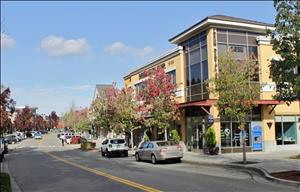On September 30, 1983, Mill Creek incorporates. After a failed attempt at development in the late 1960s, the community blooms during the latter half of the 1970s as a planned, country-club community. The city's incorporation -- Snohomish County's first since Brier in 1965 -- proceeds relatively smoothly but is not without suspense: One of the races for city council ends in a tie and is decided by a coin toss.
A Name is a Name
In the early twentieth century, a few logging and shingle mills dotted the land that would later become the city of Mill Creek. The mills were soon supplanted by farms and a resort (lakeside properties that offered cabins, picnic areas, and water fun) or two. A highway between Bothell and Everett was built through the area in the 1910s, and this road served as part of the Pacific Highway -- the main route between Seattle and Everett -- until a more direct route opened in 1927. The highway was later renamed State Route 527 (SR 527), though many know it as the Bothell-Everett Highway.
The area remained rural through the 1960s, but in 1966 developers announced plans to build a 3,300-acre planned community to be named Olympus near Wintermute's Corner at 164th Street SE and the Bothell-Everett Highway. The new community would include residential, commercial, and industrial uses, as well as a luxurious golf course and country club. During 1967 and 1968, construction seemed just around the corner. However, there were problems getting sewer service to the proposed development, and in 1969 the local economy began sliding into recession, which halted planning entirely.
The project languished until 1973, when it was purchased by a joint venture between a Seattle importer, C. T. Takahashi, and two Japanese companies, Tokyu Land Development Company and Obayahsi-Gumi Limited. Operating under the name United Development, the joint venture announced plans for a scaled-down community of 1,100 acres (but with the requisite golf course and country club) in January 1974, and construction of the golf course and clubhouse began that year. The new owners gave the community a new name, Klahanie, but changed it to Mill Creek a year or so later.
Families began moving into new homes in Mill Creek in the spring and summer of 1976, and an 18-hole golf course, six tennis courts (both indoor and outdoor), and a 19,000-square-foot clubhouse opened the same year. The community grew rapidly through the late 1970s under the tutelage of the Mill Creek Association, which provided security and maintenance and insured that various community standards were followed. By 1980 there was talk of incorporation, and the community formed an incorporation committee in December of that year.
Incorporation
In 1983, more than 200 local residents signed a petition asking for an election to determine whether Mill Creek would incorporate. This was duly approved by the Snohomish County Boundary Review Board, and an election was set for September 20. The usual arguments were made by the pro-incorporation forces, namely that Mill Creek was not being adequately represented by Snohomish County and that the community risked being annexed by Everett or Lynnwood if it did not incorporate. But there was a significant cadre in the proposed new city who were satisfied with the status quo and did not want to pay the higher taxes that would come with a new city.
Incorporation passed by a comfortable margin, but it wasn't a landslide. The final count was 453 votes in favor of incorporation, 324 opposed. Mill Creek was bounded on the west by SR 527, and the boundary jutted west of the highway north of Wintermute's Corner. Its southern boundary ran east between 164th Street SE and 168th Street SE before turning north near 25th Avenue SE, and its eastern boundary doglegged as far east as 35th Avenue SE before terminating near 140th Street SE. The northern boundary was a straight line back to SR 527. The new city's population was approximately 3,300.
Mill Creek incorporated as a non-charter code city under the council-manager form of government. (A non-charter code city is the most common form of municipal incorporation in Washington, and one that allows a municipality more local authority than other forms of incorporation.) The Secretary of State's office certified the incorporation on September 30, 1983, and the new city council met at the Mill Creek Country Club on October 4. Six councilmembers were present: Linn Epperly, Tracy Grayson, Sid Hanson, Paul Heisig, Anthony Levitsis, and Ruth Pettit. The councilmembers elected Hanson -- who had served as the chairman of the Mill Creek Incorporation Committee -- as the city's first mayor, and appointed Charles Dibble as interim city manager.
There remained the matter of electing the seventh council member. Two candidates, Virginia Milne and Gary Rhoden, had each received 259 votes in the race for Position 2. At the city council meeting, Hanson explained that the race would be decided by a coin toss in the Snohomish County Auditor's office on October 6. There was a precedent for this (the 1975 mayoral election in Clyde Hill [King County] was decided the same way), and two days later Milne and Rhoden met with county auditor Dean Williams for the ceremonial coin toss. Since Rhoden had filed for the race first, he was allowed to call it. He called "heads" and won.

